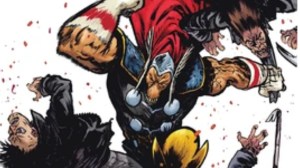
I booted up ARMS with extremely high expectations. Nintendo has never been known to approach any concept, genre, or promotion in a way you could describe as “typical.” When it came time to produce a team-shooter of its own, Nintendo went the most Nintendo route we could have imagined with Splatoon. It was colorful, inventive, completely novel, and decidedly non-violent for a third-person shooter. We went crazy for it.
Videos by ComicBook.com
Splatoon spawned a culture and fan-base as diverse and lively as the game itself, and since then we’ve been craving for more genre-warping games in the same spiritual vein. Say hello to ARMS. Nintendo took the fighting game genre and dumped it into an alchemical cauldron of sorts. The constituent mechanics and defining disciplines that make fighting games interesting and rewarding were broken down, separated, purified, and then put back together in a totally new way. Did we end up with gold, or with something less than the sum of its parts? That depends entirely on what you want out of a single-player fighting game experience.
If you participated in the ARMS Global Testpunch, then you’ve already sipped from the pool of ARMS‘ greatest offerings. Did you like what you played? Do you want more of that? If you answer yes to both of those questions, you’re going to love ARMS.
Gameplay that invites, excites, and challenges.
ARMS‘ greatest strength is its gameplay and its core mechanics, which unfold rather clumsily in the beginning, but eventually blossom into something truly wonderful. The layman will approach ARMS and flail like a adolescent playing Wii Sports for the first time. Holding a Joy-Con upright in each hand and tilting both in unison to do something as elementary as moving can be a little cumbersome at first, and it takes time to learn just how quickly and how precisely you can move the Joy-Con without throwing punches unintentionally.
That’s a critic’s analysis, anyway, but I can tell you anecdotally that none of that matters; it’s still fun. My wife has no idea how to play ARMS, but damn if she didn’t have a blast playing ARMS. This is a game that can at once cater to the clumsily flailing waggle-lover while also rewarding the lion-hearted fighting game initiate with opportunities for truly complex offensive strategies.

To truly compete in ARMS, using classic controls or motion controls, you have to commit yourself to learning its systems and its fighters — just like any other great fighting game. Eventually you hit a competitive plateau against the AI or against human opponents that you will not surpass unless you step up your game, start thinking like a strategist, and start executing like a fighter.
The level of depth here is staggering, and playing at a high level will require that you master a few characters instead of flitting from one to another. Learning how to counter grabs with mobility and simple attacks; learning how to lead with one curving punch to guide your opponent into another curving punch; executing your jumps, dashes, special attacks, and strikes with intention; using the environment to your advantage… These are the things that separate the journeyman from the apprentice, and the game is utterly addicting at the higher levels of play.
Every character is such a character.
The fighters in ARMS are so wonderfully unique and varied in their designs and abilities. Each of the ten initial fighters on this roster could star in their own comic series that I would be interested in reading.
The great thing is that this will afford serious players near limitless novelty. Truly mastering any character with their unique properties takes time, and once you master one character, you have the daunting challenge of learning how to counter every other character on the roster using those abilities and arms. Mechanica can push through lighter attacks and perform prolonged dashes, but she’s also a little more slow-going than someone like Ribbon Girl. Ribbon Girl is a double-jumping moving target who’s hard to pin down, but she’s also a bit of a lightweight. There are pros and cons to each fighter and their abilities, and they all have fantastic personalities.

The sad thing is we don’t get to learn much about these fighters at all. Splatoon offered a beefy single-player campaign which was absolutely packed with bits of lore about the world and its inhabitants. That lore was explored rather slowly and passively through bits of history you discover while navigating certain stages, but it was there, and it was engaging. ARMS doesn’t tell us any stories, and that’s a huge missed opportunity.
These characters are so unique, and they all look so different. Why are they the way that they are? Why are their arms mutated like this? How is it that regular humans and these mutants came to compete in this tournament, and why?
We don’t get to learn any of this, even through the main single player Grand Prix mode, which sends you through a series of ten fights and then gives you some credits for winning. Even some very simple still-image cutscenes telling us more about our fighters would have made for a great reward for competing in the Grand Prix. I find that I don’t really feel any incentive to go back there. I’d rather load up individual VS fights against the AI and practice that way instead.
While ARMS misses the boat on single-player arcade-mode-style content, it does offer enough to get by. The Grand Prix is there if you want it, a comprehensive practice mode will set up AI scenarios that let you practice all kinds of attacks, counters, and maneuvers, and all of the modes available in multiplayer are available to play against the AI.
Modes Galore!
I love all of the game modes in ARMS. There isn’t a single mode that I don’t have fun playing online or locally against my wife. One on one fights are of course going to be the go-to for competitive players, and I’ve already explained how much depth is waiting for you there, but there are many more game modes that I hope you’ll explore in your time with the game.

Hoops gives you an excuse to juke and spam grabs for an entire match so you can slam your opponent down through a basketball hoop. Skill shot will have you strafing from side to side trying to take out as many targets as possible while throwing long punches to smack and disrupt your opponent. Team battles and volleyball matches make for hectic, chaotic, messy matches that will have you yelling and laughing, and boss battles will bring bitter rivals together, working as groups to take down a single overpowered AI boss.
It’s all fantastic fun, and the online lobby system ensures that you’re almost always in a match playing with someone.
Looking ahead.
ARMS still has a few surprises up its sleeve, and here is another way in which we hope very much it turns out like Splatoon. Nintendo has promised continued updates bringing additional content and fighters to ARMS, and we trust that the additional content will be more than sufficient to keep us coming back. Splatoon was receiving updates constantly for over a year after launch, and all of the content was given to all players free of charge. If ARMS gets that same treatment, then this is a game that will continue to beckon us back for many, many months.
Honestly, I think you know whether ARMS is a game for you or not. If you played it (or have watched gameplay) and think that it seems like great fun, then I can promise you that there’s so much for you here, and that it’s more than worth the asking price. If you’re looking for something that can sustain you offline — something with a story and plenty of single-player content — it might be worth waiting to see what future updates bring.
For my money, ARMS represents an approachable and endlessly-deep new take on the fighting game genre. It’s colorful, rich in detail, and fun to play online and with your friends using both control schemes. If you’re at-all on the fence about this one I don’t think you’ll be disappointed, and we can’t wait for the servers to come alive so we can school you all.
WWG’s Score: 4/5









